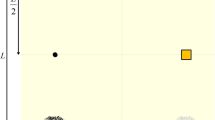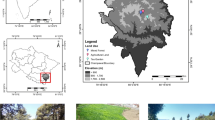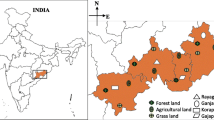Abstract
Soil fauna can sensitively respond to alterations in soil environment induced by land-use changes. However, little is known about the impact of urban land-use changes on earthworm communities. In this study, three land-use types (i.e., forest, nursery and abandoned lands) were chosen to identify differences in diversity, abundance and biomass of earthworm community in Kunming City. Urban land-use had a pronounced difference in species composition, evenness and diversity of earthworm communities. Forest land had the highest density, biomass and diversity of the earthworm communities. Total abundance was dominated by endogeic species in nursery land (70%) and abandoned land (80%), whereas in the forest land, the earthworm community comprised epigeic, endogeic and anecic species. Temporal changes in earthworm density and biomass were also significantly affected by land-use change. Total density and biomass of earthworms in the forest and nursery lands were highest in September, but highest in the abandoned land in October. The influence of soil physicochemical properties on the earthworm density and biomass also varied with land-use types. Soil temperature significantly affected earthworm density and biomass in the three land-use types. Soil pH was positively correlated with earthworm biomass in the forest land, but negatively associated with earthworm density in the abandoned land. Soil organic matter was positively correlated only with density and biomass of earthworms in the nursery and abandoned lands. Our results suggest that the species composition, abundance and biomass of earthworm communities can be determined by the modification of soil properties associated with urban land-use type.



Similar content being viewed by others
References
Araujo Y, Luizão FJ, Barros E (2004) Effect of earthworm addition on soil nitrogen availability, microbial biomass and litter decomposition in mesocosms. Biol Fert Soils 39(3):146–152
Baker GH (1998) Recognising and responding to the influences of agriculture and other land-use practices on soil fauna in Australia. Appl Soil Ecol 9(1):303–310
Bertin C, Yang X, Weston LA (2003) The role of root exudates and allelochemicals in the rhizosphere. Plant Soil 256(1):67–83
Bini D, Cristiane ADS, Kellen BDC, Nagomi K, Galdino A, Waldemar Z, Marco AN (2013) Effects of land use on soil organic carbon and microbial processes associated with soil health in southern Brazil. Eur J Soil Biol 55(3):117–123
Birkhofer K, Schöning I, Alt F, Herold N, Klarner B, Maraun M, Begerow D (2012) General relationships between abiotic soil properties and soil biota across spatial scales and different land-use types. PLoS ONE 7(8):e43292
Blakemore RJ (2000) Ecology of earthworms under the ‘Haughley Experiment’ of organic and conventional management regimes. Biol Agric Hortic 18(2):141–159
Bohlen PJ, Scheu S, Hale CM, McLean MA, Migge S, Groffman PM, Parkinson D (2004) Non-native invasive earthworms as agents of change in northern temperate forests. Front Ecol Environ 2(8):427–435
Cerdà A (1998) Soil aggregate stability under different Mediterranean vegetation types. CATENA 32(2):73–86
Decaëns T, Mariani L, Lavelle P (1999) Soil surface macrofaunal communities associated with earthworm casts in grasslands of the Eastern Plains of Colombia. Appl Soil Ecol 13(1):87–100
Decaëns T, Bureau F, Margerie P (2003) Earthworm communities in a wet agricultural landscape of the Seine Valley (Upper Normandy, France): the 7th international symposium on earthworm ecology· Cardiff· Wales· 2002. Pedobiologia 47(5–6):479–489
Dempsey MA, Fisk MC, Yavitt JB, Fahey TJ, Balser TC (2013) Exotic earthworms alter soil microbial community composition and function. Soil Biol Biochem 67:263–270
Dlamini TC, Haynes RJ (2004) Influence of agricultural land use on the size and composition of earthworm communities in northern KwaZulu-Natal, South Africa. Appl Soil Ecol 27(1):77–88
Du J, Yang XD, Zhang H, Yu GB (2008) Quantitative distribution of earthworms and its relationships with environmental factors in tropical secondary forest and rubber plantation in Xishuangbanna. Chin J Ecol 27(11):1941–1947
Edwards CA, Bohlen PJ (1996) Biology and ecology of earthworms, vol 3. Chapman & Hall, London
Eisenhauer N, Partsch S, Parkinson D, Scheu S (2007) Invasion of a deciduous forest by earthworms: changes in soil chemistry, microflora, microarthropods and vegetation. Soil Biol Biochem 39(5):1099–1110
Emmerling C, Schloter M, Hartmann A, Kandeler E (2015) Functional diversity of soil organisms-a review of recent research activities in Germany. J Plant Nutr Soil Sci 165(4):408–420
Gong L, Ran Q, He G, Tiyip T (2015) A soil quality assessment under different land use types in Keriya river basin, Southern Xinjiang, China. Soil Tillage Res 146:223–229
González G, García E, Cruz V, Borges S, Zalamea M, Rivera MM (2007) Earthworm communities along an elevation gradient in Northeastern Puerto Rico. Eur J Soil Biol 43(54):S24–S32
Groffman PM, Fahey TJ, Fisk MC, Yavitt JB, Sherman RE, Bohlen PJ, Maerz JC (2015) Earthworms increase soil microbial biomass carrying capacity and nitrogen retention in northern hardwood forests. Soil Biol Biochem 87:51–58
Hale CM, Frelich LE, Reich PB (2006) Changes in hardwood forest understory plant communities in response to European earthworm invasions. Ecology 87(7):1637–1649
Hättenschwiler S, Tiunov AV, Scheu S (2005) Biodiversity and litter decomposition in terrestrial ecosystems. Annu Rev Ecol Evol Syst 36(36):191–218
Jouquet P, Zangerlé A, Rumpel C, Brunet D, Bottinelli N, Tran Duc T (2009) Relevance and limitations of biogenic and physicogenic classification: a comparison of approaches for differentiating the origin of soil aggregates. Eur J Soil Sci 60(6):1117–1125
Li QF, Zhang JE, Qin Z (2013) Soil faunal community structure in winter season under various land use types in Guangzhou. Chin J Eco-Agric 20(11):1521–1526
Omondi EC, Ridenour M, Ridenour C, Smith R (2010) The effect of intercropping annual ryegrass with pinto beans in mitigating iron deficiency in calcareous soils. J Sustain Agric 34(3):244–257
Plum NM, Filser J (2005) Floods and drought: response of earthworms and potworms (Oligochaeta: Lumbricidae, Enchytraeidae) to hydrological extremes in wet grassland. Pedobiologia 49(5):443–453
Ruan H, Li Y, Zou X (2005) Soil communities and plant litter decomposition as influenced by forest debris: variation across tropical riparian and upland sites. Pedobiologia 49(6):529–538
Sheehan C, Kirwan L, Connolly J, Bolger T (2006) The effects of earthworm functional group diversity on nitrogen dynamics in soils. Soil Biol Biochem 38(9):2629–2636
Tian G, Olimah JA, Adeoye GO, Kang BT (2000) Regeneration of earthworm populations in a degraded soil by natural and planted fallows under humid tropical conditions. Soil Sci Soc Am J 64(1):222–228
Uren NC (2007) Types, amounts, and possible functions of compounds released into the rhizosphere by soil-grown plants. CRC Press, Boca Raton, pp 1–21
Wang SJ, Ruan HH (2008) Feedback mechanisms of soil biota to aboveground biology in terrestrial ecosystems. Biodivers Sci 16(4):407–416
Wang SJ, Cai QJ, Ruan HH (2007) Soil nematode community response to vegetation restoration in northern Fujian. Biodivers Sci 15(4):356–364
Wang X, Li HX, Zhu L, Liu B, Hu F (2008) Effects of earthworms on soil N mineralization. Acta Pedol Sin 45(4):641–648
Wang SJ, Ruan HH, Wang JS, Xu ZK, Wu YY (2010) Composition structure of soil fauna community under the typical vegetations in the Wuyi mountains, China. Acta Ecol Sin 30(19):5174–5184
Wang SJ, Tan Y, Fan H, Ruan H, Zheng A (2015) Responses of soil microarthropods to inorganic and organic fertilizers in a poplar plantation in a coastal area of eastern China. Appl Soil Ecol 89:69–75
Wang SJ, Wang H, Li JH (2017) Effects of different land use types on spatial-temporal distribution of earthworm density and biomass. Chin J Ecol 36(1):118–123
Wardle DA, Bardgett RD, Klironomos JN, Setälä H, Van Der Putten WH, Wall DH (2004) Ecological linkages between aboveground and belowground biota. Science 304(5677):1629–1633
Yu ZY, Wei WH, Xue QY, Wang J (2007) Effect of environment factors on the reproduction of Pheretima pingi. J Nanjing Norm Univ Nat Sci Ed 30(3):107–111
Zhang WX, Li JX, Guo MF, Liao CH (2005) Seasonal variation of earthworm community structure as correlated with environmental factors in three plantations of Heshan, Guangdong, China. Acta Ecol Sin 25(6):1362–1370
Zhang WX, Chen MD, Zhao CC (2007) Functions of earthworm in ecosystem. Biodivers Sci 15(2):142–153
Zhang N, Liao Y, Sun FL, Wang C, Sun ZJ (2012) Earthworm population characteristics in soils different in land use and their relationships with biological fertility of the soils. Acta Pedol Sin 49(2):364–372
Acknowledgements
This research was supported by the China 948 Program of National Forestry Bureau (2015-4-39), the National Science Foundation of China (No. 41461052; 31660191), Yunnan education department project (2017YJS089).
Author information
Authors and Affiliations
Corresponding author
Additional information
Project funding: This research was supported by the China 948 Program of National Forestry Bureau (2015-4-39), the National Science Foundation of China (No. 41461052; 31660191), and Yunnan education department project (2017YJS089).
The online version is available at http://www.springerlink.com
Corresponding editor: Chai Ruihai.
Rights and permissions
About this article
Cite this article
Li, J., Zhang, Z., Wang, H. et al. Urban land-use impacts on composition and spatiotemporal variations in abundance and biomass of earthworm community. J. For. Res. 31, 325–331 (2020). https://doi.org/10.1007/s11676-018-0807-2
Received:
Accepted:
Published:
Issue Date:
DOI: https://doi.org/10.1007/s11676-018-0807-2




